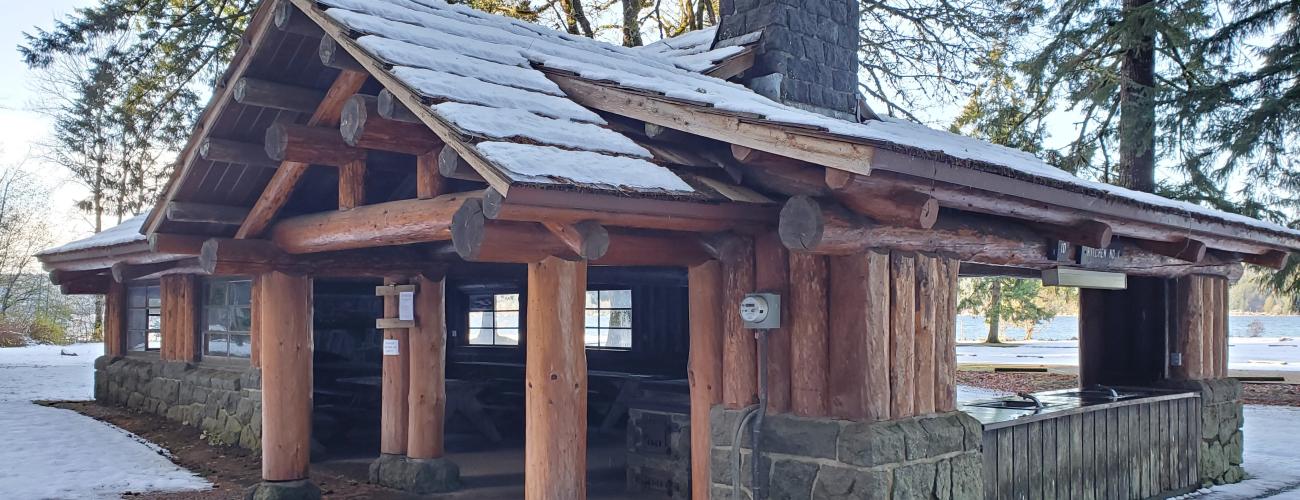Twanoh State Park History
Twanoh State Park is a delightful place on the southern reach of Hood Canal. Its attractive beach at the mouth of cold, clear Twanoh Creek has long attracted people.
Indigenous Lands
The park lies within the traditional territory of Coast Salish Indigenous people whose present-day descendants include members of the Skokomish Indian Tribe and Suquamish Tribe. Local tribes ceded ownership of the area under duress to the US federal government in the Treaty of Point No Point in 1855, keeping rights to harvest natural resources in their usual and accustomed places, including the beaches and waters of Hood Canal and its tributaries. After government land surveys were completed in 1861, the land now making up the core of today’s Twanoh State Park passed into private ownership with Cash Entry Patents, a type of land sale of public domain lands, to Herman Hilgenfeld and Bernt Anseth in 1891. The area was developed as a private resort centered on the beach that bordered Hood Canal.
First State Park Acquired by Purchase
In 1922, the Washington State Parks Committee leased the resort land within today’s Twanoh State Park with an option to purchase. In 1921, the Washington State Legislature had provided a means for purchasing lands for state park purposes with funds appropriated from “25% of the fines collected on account of infractions and violations of the traffic code outside of incorporated towns and cities.” When sufficient funding had accumulated in the account, the initial 40 acres of land in two parcels was purchased. On March 20, 1923, the sale was finalized for $4,150, becoming the first Washington State Park acquired by purchase.
The park was dedicated on June 9, 1923, named Twanoh to honor the language spoken by Indigenous people of southern Hood Canal. Easy access by personal automobile was provided by the Navy Yard Highway, also completed in 1923. Its attractive location with views of the Olympic Mountains, beaches and a swimming lagoon led to it becoming one of the most popular state parks by 1926.
In the 1930s as the Great Depression deepened, people throughout Washington and across the US struggled with poverty as job losses and business closures erased their economic security. Newly elected President Franklin D. Roosevelt moved fast to provide material relief for suffering families. The Public Works Administration (PWA) was created to provide funding for roads, buildings and other projects to serve the public and provide employment. In 1934, $14, 955.49 was provided for PWA work at Twanoh State Park.
Twanoh State Park’s popularity led to damaging impacts from uncontrolled parking and camping. After a visit in May 1934, State Parks Committee Superintendent William G. Weigle proposed improvements to Twanoh State Park paid for with the PWA funds. These included a bath house, two comfort stations, a community kitchen, a swimming dock and landscaping and development of a tidal wading pool. He also suggested that rock and log cribbing was needed to contain Twanoh Creek during fall floods. Architects with the National Park Service (NPS) were hired to design the new facilities in the NPS’s signature “rustic” style, using local stone, logs and bricks intended to blend in with the landscape. Bids were received from private construction firms. Two contracts were approved and some of the work was completed by June 1935.
The Civilian Conservation Corps
The Civilian Conservation Corps (CCC) was established as another program of President Roosevelt’s “New Deal.” It provided useful employment and training for single men aged 18 to 25, and ultimately employed more than 2 million enrollees who performed work in national and state parks and forests at more than 500 camps.
CCC Company 294 arrived at Twanoh State Park on August 2, 1935, from a previous assignment with the Tennessee Valley Authority. They were quartered at an existing CCC camp near Belfair that had been built in 1933. The CCC enrollees completed several more buildings in the park, including additional community kitchens, comfort stations, a concession building, and the caretaker’s house. The natural spit and lagoon were modified to create an enclosed, shallow saltwater wading pool regulated by a manually operated tide gate, drain and culvert.
Company 294 was replaced by Company 4728 from North Dakota on October 10, 1936, and continued to work on projects until 1938. The community kitchens, restrooms, campground, and picnic areas built by the CCC with simple hand tools and locally sourced building materials remain mostly intact today, a testament to high quality workmanship.
Protecting and Restoring the Nearshore Ecosystem
Ecologists recognize that one of the most significant parts of the landscape is the nearshore ecosystem. The band of beaches, bluffs, deltas and shallow water (the photic zone) that makes up the nearshore ecosystem are vital to many species which depend on it for a part or all of their life cycle. It has also been heavily affected by development.
Twanoh State Park has been recognized as an important place to protect the nearshore ecosystem. It retains many healthy elements, and the modifications made to the park’s shoreline and Twanoh Creek by PWA and CCC projects have been the subject of ongoing restoration efforts in recent years, furthering the Washington State Parks and Recreation Commission’s mission to care for Washington’s most treasured lands, waters and historic places.
Sharing the histories of Washington’s state parks is an ongoing project. Learn more here.

